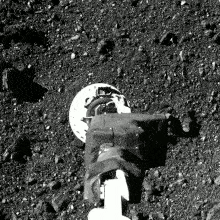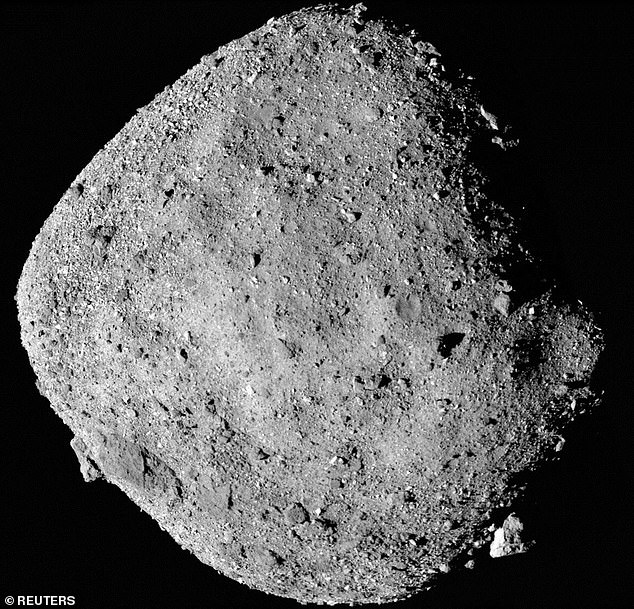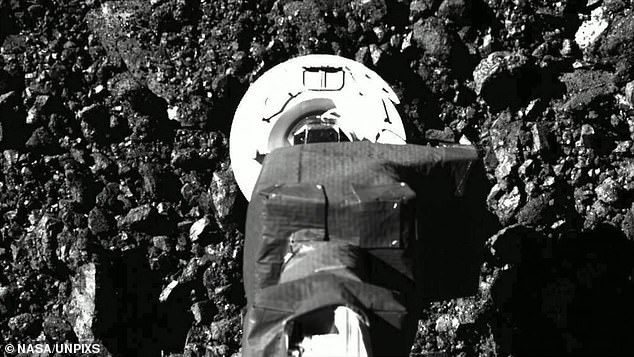Finally! NASA finally removes the lid from the Bennu asteroid capsule after two screws got stuck – more than three months since the precious cargo returned to Earth
It’s been several months, but NASA has finally taken the lid off the capsule that returned the Bennu asteroid to Earth.
NASA engineers removed two metal fasteners from the TAGSAM robotic arm that kept the lid secured and the precious cargo trapped inside.
Now, analyzing the entire 250-gram sample for clues about the history of the solar system can begin.
It was in October 2020 that the robotic arm aboard the OSIRIS-REx spacecraft grabbed a handful of the Bennu asteroid.
Space fans rejoiced last September when the spacecraft finally returned to Earth, marking the end of the $1.16 billion mission, one of NASA’s most ambitious ever.
NASA engineer Neftali Hernandez uses one of the tools developed to remove two final fasteners that prevented the complete disassembly of the TAGSAM (Touch-and-Go Sample Acquisition Mechanism) head that contains the rest of the material recovered from Bennu collected in the OSIRIS-REx sapce capsule

Timelapse of the 5-minute period on October 20, 2020 when the arm grabbed the sample from Bennu – an asteroid 200 million miles away
According to Eileen Stansbery, department head for ARES (Astromaterials Research and Exploration Science) at NASA’s Johnson Space Center in Houston, new tools had to be designed to remove the last two screws and open the capsule.
“Our engineers and scientists have worked tirelessly behind the scenes for months to not only process the more than 70 grams of material we previously had access to, but also to design, develop and test new tools to help us overcome this hurdle. ‘ she said.
“The innovation and dedication of this team was remarkable.
“We are all excited to see the remaining treasure that OSIRIS-REx holds.”
Since the monster’s triumphant return to Earth in September, NASA has managed to open only the top lid of the capsule, revealing a curious black dust.
However, Bennu’s rocky handful was stored in another smaller component inside – which has finally been opened.
The precious cargo is an estimated 8.8 ounces, or 250 grams of rocky material – only about half of what you would find in an average-sized cereal box.

This mosaic image of asteroid Bennu, composed of 12 PolyCam images collected on December 2, 2018 by the OSIRIS-REx spacecraft from a distance of 24 km

In this image from a video released by NASA, the Osiris-Rex spacecraft hits the surface of asteroid Bennu on October 20, 2020. The spacecraft later departed for Earth in May 2021.
But NASA thinks it will be enough to reveal secrets about the composition of asteroids and “help us better understand the types of asteroids that could threaten Earth.”
The pebbles and dust from Bennu – which could hit Earth in 2182 – represent the largest spoils from beyond the moon.
It was in September 2016 that the OSIRIS-REx spacecraft was launched from Cape Canaveral, Florida – and did not arrive at Bennu until December 2018.
After mapping the asteroid for almost two years, he collected a sample of its surface on October 20, 2020. returning home – a round trip of 3.86 billion miles.
Although a straight path between Earth and the asteroid is 200 million miles, the total distance the spacecraft traveled was much longer because it took a much longer, winding path, requiring several maneuvers.
The craft carrying the precious sample landed on a remote military site in the western state of Utah on September 24.

A helicopter will deliver a space capsule containing NASA’s first asteroid samples to a temporary cleanroom at Dugway Proving Ground in Utah on Sunday. The Osiris-Rex spacecraft has released the capsule after a seven-year journey to asteroid Bennu and back
Within two hours of landing, the capsule was in a temporary cleanroom at the Defense Department’s Utah Test and Training Range, having been airlifted there by helicopter.
It was then flown to NASA’s Johnson Space Center in Houston, Texas, where experts dressed in protective suits opened the first lid and found black dust.
Scientists planned to completely disassemble the capsule and extract and weigh the sample before putting it back through two of the 35 fasteners.
Later this spring, the curatorial team will release a catalog of the OSIRIS-REx samples, which will be available to the global scientific community.
